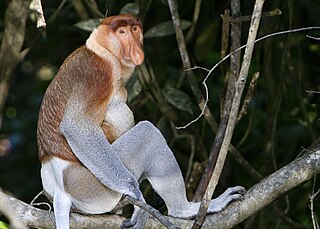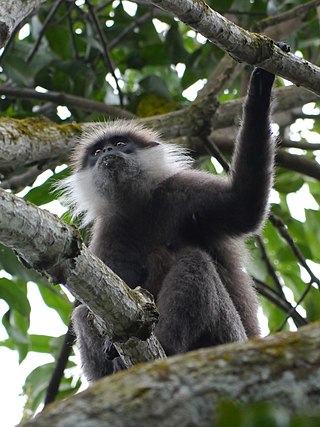
Primates is an order of mammals, which is further divided into the strepsirrhines, which include lemurs, galagos, and lorisids; and the haplorhines, which include tarsiers; and the simians, which include monkeys and apes. Primates arose 85–55 million years ago first from small terrestrial mammals, which adapted for life in tropical forests: many primate characteristics represent adaptations to the challenging environment among tree tops, including large brain sizes, binocular vision, color vision, vocalizations, shoulder girdles allowing a large degree of movement in the upper limbs, and opposable thumbs that enable better grasping and dexterity. Primates range in size from Madame Berthe's mouse lemur, which weighs 30 g (1 oz), to the eastern gorilla, weighing over 200 kg (440 lb). There are 376–524 species of living primates, depending on which classification is used. New primate species continue to be discovered: over 25 species were described in the 2000s, 36 in the 2010s, and six in the 2020s.

The proboscis monkey or long-nosed monkey is an arboreal Old World monkey with an unusually large nose, a reddish-brown skin color and a long tail. It is endemic to the southeast Asian island of Borneo and is found mostly in mangrove forests and on the coastal areas of the island.

Presbytis is a genus of Old World monkeys also known as langurs, leaf monkeys, or surilis. Members of the genus live in the Thai-Malay Peninsula, on Sumatra, Borneo, Java and smaller nearby islands.

The pig-tailed langur, monotypic in genus Simias, is a large Old World monkey, endemic to several small islands off the coast of Sumatra in Indonesia. Its face is black, its fur is black-brown and it has a relatively short tail. It is a diurnal species, feeding in the rainforest canopy on leaves, and to a lesser extent, fruit and berries. Little is known of its natural history, but it is heavily hunted, its populations have been declining rapidly and the International Union for Conservation of Nature has assessed its conservation status as being "critically endangered". It has been included on a list of the World's 25 Most Endangered Primates.

The Sumatran orangutan is one of the three species of orangutans. Critically endangered, and found only in the north of the Indonesian island of Sumatra, it is rarer than the Bornean orangutan but more common than the recently identified Tapanuli orangutan, also found in Sumatra. Its common name is based on two separate local words, "orang" and "hutan" ("forest"), derived from Malay, and translates as 'person of the forest'.

The Bornean orangutan is a species of orangutan endemic to the island of Borneo. Together with the Sumatran orangutan and Tapanuli orangutan, it belongs to the only genus of great apes native to Asia. It is the largest of the three species of orangutans. Like the other great apes, orangutans are highly intelligent, displaying tool use and distinct cultural patterns in the wild. Orangutans share approximately 97% of their DNA with humans. Also called mias by the local population, the Bornean orangutan is a critically endangered species, with deforestation, palm oil plantations, and hunting posing a serious threat to its continued existence.

Phayre's leaf monkey, also known as Phayre's langur, is a species of Old World monkey native to South Asia and Southeast Asia, namely India, Bangladesh, and Myanmar. Populations from further east are now thought to belong to other species. It is listed as Endangered on the IUCN Red List and is threatened by hunting and loss of habitat. The species epithet commemorates Arthur Purves Phayre.

The Raffles' banded langur, also known as the banded leaf monkey or banded surili, is a species of primate in the family Cercopithecidae. It is endemic to Singapore and southern Peninsular Malaysia. The species underwent taxonomic revisions in 2019 and 2020, in which two former subspecies were elevated to separate species. As a result, the Raffles' banded langur meets the criteria for being listed as critically endangered by the IUCN. It is mainly threatened by habitat loss.

Hose's langur is a species of primate in the family Cercopithecidae endemic to the island of Borneo, including Brunei, Kalimantan (Indonesia), and East Malaysia. Its natural habitat is subtropical or tropical dry forests. It is threatened by habitat loss. It was first identified in Kutai National Park and Sangkulirang Peninsula, East Kalimantan, Indonesia, in 1985.

The maroon langur, maroon leaf monkey, or red leaf monkey is a member of the family Cercopithecidae. It is found on the southeast Asian island of Borneo and the nearby smaller Karimata. P. rubicunda mostly live in forests at altitudes below 2,000 m. They feed on leaves, seeds, and fruits.

Thomas's langur, also known as the North Sumatran leaf monkey or Thomas's leaf monkey, is a species of primate in the family Cercopithecidae. It is endemic to northern Sumatra, Indonesia, not living to the south and east of Lake Toba and the Alas and Wampu rivers. Its natural habitat is subtropical or tropical dry forests. It is threatened by habitat loss. Its native names are reungkah in Acehnese and kedih in Alas. It can be found in Gunung Leuser National Park, where substantial populations exist in Ketambe and Bukit Lawang.

The dusky leaf monkey, also known as the spectacled langur or the spectacled leaf monkey, is a species of primate in the family Cercopithecidae. It is found in Peninsular Malaysia, Myanmar and Thailand, and can occasionally be found in Singapore. During the day, these small, folivorous primates divide in sub-groups and forage for vegetation and fruit throughout the tropical forests. According to the IUCN, the dusky leaf monkey's population is declining due to habitat loss, poaching, and anthropogenic land use, which prompted the IUCN to classify the species as endangered in 2015.

Willie Smits is a trained forester, a microbiologist, conservationist, animal welfare activist, wilderness engineer and social entrepreneur. He has lived in Indonesia since 1985 and is an Indonesian citizen. He is married to Adrienne C. Watson since March 2016.

The western purple-faced langur, also known as the north lowland wetzone purple-faced langur, is a subspecies of purple-faced langur endemic to Sri Lanka. It lives in the wet zone in western Sri Lanka around the former capital city of Colombo. This subspecies are known to live in tropical rainforest, specifically in an area of Sri Lanka, where it is noted to rain two times more compared to the neighboring region. The subspecies is generally gray-brown with lighter whiskers, a gray rump patch, and dark forearms and legs. These monkeys also have dark brown or black, hairless faces. Their hands and feet are also hairless. When infants, their fur is medium brown to light gray, however it changes to their darker adult colors at between 12 and 16 weeks old. Typical length is between 48 and 67 centimetres excluding tail, with a 59 to 85 centimetres tail. On average, males weigh 8.5 kilograms (19 lb) and females weigh 7.8 kilograms (17 lb). Their average life span is about 26 years if the monkey was held in captivity. Due to their leafy diet, the western purple-faced langur back teeth, include high crowns and pointed cusps to make eating through greenery simpler. They also developed a digestive system that would allow them to break down cellulose in the leaves they eat. Although, leaves are their primary source of food, they also eat fruits and flowers. Female langurs hold a pregnancy for 195–210 days, and after the birth the offsprings are taken closely cared for by the mother until they are about 12–20 weeks old.
Wehea Forest is a 38,000 ha rainforest located in East Kutai Regency, East Kalimantan, Borneo. Wehea was declared a protected forest in 2004 by the Wehea Dayak. This project received the Kalpataru Award in 2009, Indonesia's highest environmental honor. It currently is a co-managed forest between the local Wehea Dayak people from the village of Nehas Liah Bing and Wehea Management Body. The Kepala Adat of Nehas Liah Bing is Ledjie Taq.

Line Gordon is a Swedish sustainability scientist whose transdisciplinary research combines food, water, and the benefits people receive from nature. Gordon is the director of the Stockholm Resilience Centre and a professor at Stockholm University, Sweden. She is also on the board of the EAT foundation, and often participates in public discussions of food and climate in Sweden.

The planetary health diet, also called a planetary diet or planetarian diet, is a flexitarian diet created by the EAT-Lancet commission as part of a report released in The Lancet on 16 January 2019. The aim of the report and the diet it developed is to create dietary paradigms that have the following aims:

The Sabah grizzled langur, also known as the Saban grizzled langur, is a species of monkey in the family Cercopithecidae. It was formerly considered a subspecies of Hose's langur, Presbytis hosei. The Sabah grizzled langur is native to the island of Borneo in the province of Sabah in Malaysia, with part of its range in Indonesia. It is listed as endangered by the IUCN due primarily to habitat loss, fragmentation and hunting.

Miller's langur, also known as Miller's grizzled langur or Kutai grey langur, is a species of leaf monkey. It is endemic to East Kalimantan on the island of Borneo in Indonesia. It is one of the world's most endangered primates, and was at one time thought to be extinct, until it was rediscovered in 2012.
Beatrice Crona is an ecologist, a professor at Stockholm University, and the Executive Director of the Program on Global Economic Dynamics and the Biosphere at the Royal Swedish Academy of Sciences. In 2023 she became a Science Director of the Stockholm Resilience Centre.


















